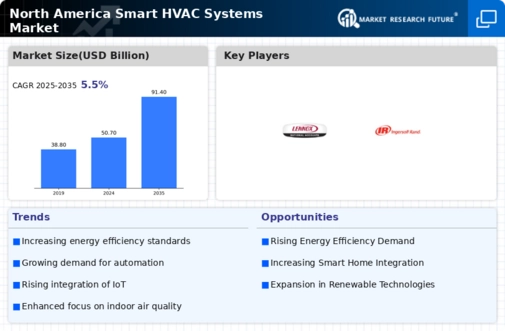Government Incentives and Rebates
Government incentives and rebates are significantly impacting the Global North America Smart HVAC Systems Market Industry. Various federal and state programs are designed to encourage the adoption of energy-efficient HVAC systems, providing financial incentives for consumers and businesses. These initiatives not only lower the upfront costs associated with purchasing smart HVAC systems but also promote long-term energy savings. As a result, the market is poised for growth, as these incentives are likely to stimulate consumer interest and drive sales, aligning with broader sustainability goals.
Rising Energy Efficiency Standards
The Global North America Smart HVAC Systems Market Industry is experiencing a notable shift towards enhanced energy efficiency standards. Regulatory bodies are increasingly mandating stricter energy consumption guidelines, compelling manufacturers to innovate and integrate smart technologies into HVAC systems. For instance, the U.S. Department of Energy has set ambitious targets for energy efficiency, which are expected to drive the market's growth. As a result, the market is projected to reach 45.67 USD Billion in 2024, reflecting a growing consumer preference for energy-efficient solutions that not only reduce utility bills but also contribute to environmental sustainability.
Increased Focus on Indoor Air Quality
The emphasis on indoor air quality (IAQ) is becoming a critical driver in the Global North America Smart HVAC Systems Market Industry. With growing awareness of health issues related to poor air quality, consumers are prioritizing HVAC systems that offer advanced filtration and air purification features. Regulatory agencies are also advocating for improved IAQ standards, further propelling the demand for smart HVAC solutions. As a result, manufacturers are investing in technologies that monitor and enhance air quality, which is likely to contribute to the market's expansion as consumers seek healthier living environments.
Growing Demand for Smart Home Solutions
The demand for smart home solutions is significantly influencing the Global North America Smart HVAC Systems Market Industry. As consumers increasingly seek convenience, comfort, and energy savings, smart HVAC systems that can be controlled remotely via smartphones or voice-activated devices are gaining traction. This trend is particularly evident in urban areas, where space constraints necessitate efficient climate control solutions. By 2035, the market is anticipated to grow to 85.23 USD Billion, driven by the integration of HVAC systems with other smart home technologies, creating a seamless user experience that enhances overall home automation.
Technological Advancements in HVAC Systems
Technological advancements play a pivotal role in shaping the Global North America Smart HVAC Systems Market Industry. Innovations such as IoT integration, machine learning, and advanced sensors are revolutionizing HVAC systems, enabling real-time monitoring and predictive maintenance. These technologies enhance system performance and user experience, leading to increased adoption among both residential and commercial sectors. The market is likely to witness a compound annual growth rate of 5.84% from 2025 to 2035, driven by the continuous evolution of smart technologies that optimize energy usage and improve indoor air quality.















Leave a Comment